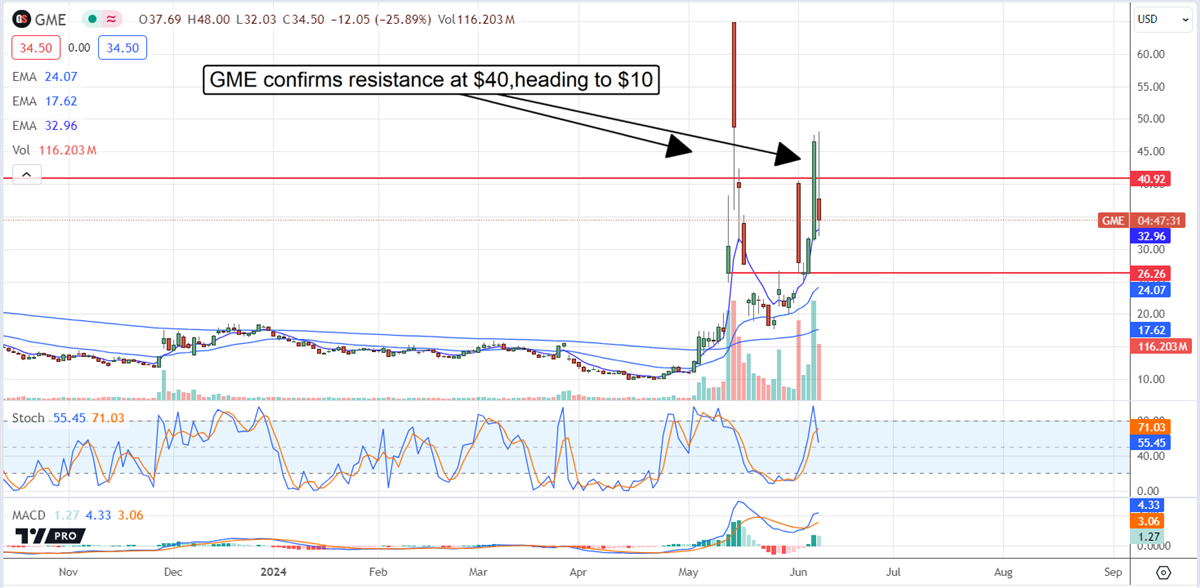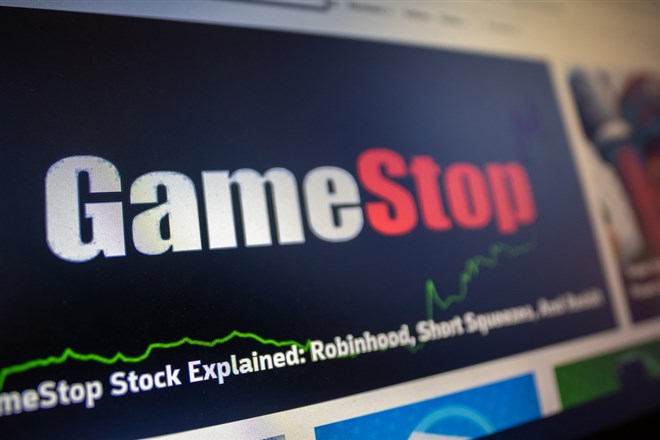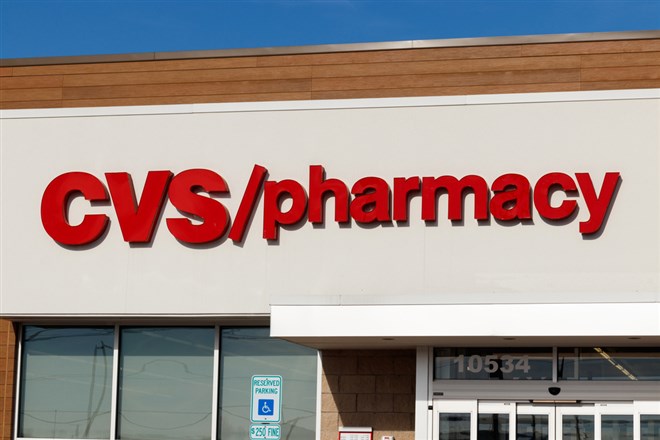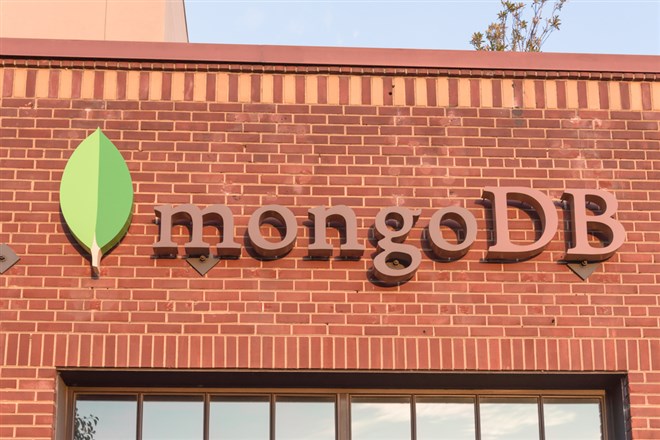Ticker Reports for June 9th
GameStop Stock is Heading Back to the $10 Level Soon: Take 2
GameStop (NYSE: GME) shares have retested the $10 level once and will do it again because the company is lost. Like Blockbuster before it, its once-hot business lost relevancy and has nowhere to go but out of business, and it looks like the failure is accelerating. The takeaways from the Q1 report are that this company is shedding business fast, losing money, and diluting shareholder value in a way that will make many short-sellers drool.
Among the biggest takeaways is the company's plans for another share sale. The company registered to sell up to 75 million more shares, 65% more than the sale completed last month and will dilute value again. The only good news is that GameStop will be able to shore up its balance sheet and keep itself in business for longer, providing more opportunities for meme-mania to drive volatility and entertainment value.
GameStop Circles the Drain as it Slowly Eats Itself to Death
The capital drain, share sales, and dilution offered by GameStop are no-win situations for investors. The company reported $881.8 million in revenue for the quarter. There is some business to be found, but this is 29% lower than last year and 50% lower than last quarter, suggesting deterioration is accelerating.
The revenue is also weaker than expected, and there is no hope for it to pick up due to the rapidly changing nature of video games from traditional models to cloud-based. Segmentally, all units performed poorly, leading to a 30% decline in the key hardware and software segments. Collectibles sales fell by 20%.
Margin news is mixed. The company improved the gross margin and reduced the year-over-year losses. Still, deleveraging and increased costs cut into the operating margin, leaving losses that were worse than expected on a GAAP and adjusted basis. The adjusted loss of $0.12 is 3300 basis points short of the consensus and is not expected to improve this year.
The balance sheet is still in good shape and even great despite the cash burn. The company sold some marketable securities during the quarter, bolstered the cash balance, and still has no significant debt. The cash balance is just over $1 billion and does not reflect last month's share sales. Adding that to the balance should put it near $2 billion at the end of the current quarter, not counting any new sales.
The new filing allows for 75 million shares, diluting value by another double-digit amount but potentially raising another $1 billion or more in proceeds. The question is whether Mr. Cohen and GameStop can use that money to drive income and value or if it will slowly burn away as this company eats itself to death.
GameStop Market Has Little Conviction
There are some high-conviction participants in the GameStop market, but the market itself has no conviction that matters to investors. The analysts don’t buy, hold, or even sell it, and the institutions avoid it. Short-sellers are still in the mix and likely doubling down, with the price flip-flopping to multi-year highs on meme-mania. This means to investors and traders that volatility is the only thing to count on, and the bias for long-term action is lower.
The price action in GME spiked in early market trading due to an announced live stream by Roaring Kitty, but it was quickly reversed. The early release of the Q1 results and announced share sale results in a 50% contraction from the early highs, leaving the market under pressure. The price action confirms resistance at $40 and suggests a move back to $20 or lower is coming. A move below $20 would be very bearish and likely lead to $10. If this thing hits $10 again, the odds are high it will fall into the single-digit range.

WARNING: Before Elon gets on stage…
Before Elon gets on stage to make a shocking AI announcement in the coming days…
Tim Bohen is holding an emergency briefing on June 13th to reveal a unique opportunity.
Top 3 Bargain Stocks to Watch Near Their 52-Week Low Prices
Stocks are often exposed to the emotional ups and downs of the market cycle, where investors tend to amplify bullish and bearish sentiment, reflecting these extremes in their price swings. What savvy investors can do is take advantage of these swings to the benefit of their wealth-building pursuits, also known as buying the dip. Today, three stocks stand out when scanning for price action.
CVS Health Co. (NYSE: CVS) is topping this list, trading at only 72% of its 52-week high price. It is followed by Nike Inc. (NYSE: NKE), which recently fell to 77% of its 52-week high price. Lastly, McDonald’s Co. (NYSE: MCD) has traded down to 85% of its 52-week high.
These stocks are big enough in their consumer discretionary and healthcare sectors. Their market capitalizations should be enough to keep these companies from falling to the low levels they have lost to today. Because of their recent discounts, they may soon be in the hands of those looking for solid brands to load onto their portfolios.
Why Free Cash Flow Matters More Than Ever in Today’s Economy
When the COVID-19 pandemic hit its peak months, the Federal Reserve (the Fed) was forced to lower interest rates to near zero to boost the economy through forced lockdowns. Because of cheap money and financing, the market has become complacent about taking on risk.
What media outlets may call a ‘risk on’ attitude created a false sense of ease for investors to profit in the markets, but that changes today. As the U.S. GDP growth rate was revised down to only 1.3% in the past quarter, a period that also saw inflation above 3%, the economy is now under a phenomenon called stagflation.
Defined as low economic growth along with high inflation, this environment calls for companies that can compound their capital reliably and predictably, which is where free cash flow (operating cash flow minus capital expenditures) comes into play, as it isn’t as easily manipulated as net income on a company’s financial statement.
How CVS Stock’s Free Cash Flow Leverages Technology Investments for Future Growth
Unlike its rival, Walgreens Boots Alliance Inc. (NASDAQ: WBA), CVS has ample room to reinvest its profits into growth developments that will likely propel its stock price higher in the coming years. In its second quarter 2024 earnings results, Walgreens posted an operating cash outflow of $918 million, leaving the company with no cash flow to invest with.
On the other hand, CVS posted an operating cash flow of $4.9 billion. Even after investing $705 million into capital expenditures, the company had roughly $4.2 billion left in free cash flow to do a few cool things for its investors.
First, it bought $3 billion worth of stock, or roughly 30 million shares. This profitability also allowed management to partner with Microsoft Co. (NASDAQ: MSFT) and its cloud computing (Azure) healthcare capabilities.
Because of this, CVS could likely differentiate itself from Walgreens in the coming years, making today’s price level somewhat of a bargain for investors looking to beat stagflation. Analysts at J.P. Morgan Chase also think that CVS could reach up to $86 a share, daring it to rally by 40.5% from where it trades today.
Nike Stock on the Rise: Returning to True Value After Recent Dip
After struggling to break out of its $90 to $100 a share channel, Nike stock investors could find a new reason to keep buying, and it’s all found in the company’s financials.
Its positioning in the global athletic brands market drives the company’s moat and strong financials, of which Nike takes 43.7%. Because of this worldwide penetration and recognition, the company can generate returns on invested capital (ROIC) rates of over 12% a year.
ROIC is essential because it's how a business compounds its capital, and a 12% rate or more definitely helps beat stagflation today.
More than that, today's P/E ratio of 28.4x makes Nike stock the cheapest it has been since 2016 (Ex. COVID). Analysts could be right about the projected 21% upside through a $116.3 share price target.
Why McDonald’s Can Outpace Inflation and Grow Profits
Another giant moat is found in McDonald’s stock, taking a similar 43.8% market share over the fast food industry, opening a path for management to leverage this pricing power and global presence into compounding profits for shareholders.
This trend can be spotted in the company’s 16% plus ROIC rates over the past five years, making today’s 22x P/E ratio not only the cheapest in nearly a decade but also unjustifiably low, considering how reliable the business is at compounding investor wealth.
There’s a reason why Warren Buffett owns the stock, and posting $7.1 billion in free cash flow over the past year could be one of them. With this profitability, McDonald’s management gave back $3.4 billion to its shareholders by buying back over 10 million shares off the market.
Wall Street analysts see these trends as a surefire way to escape stagflation. They now project a 22% upside from today’s prices via a $316.2 share price target.
The 10 Best AI Stocks for 2024
Are you ready to capitalize on the booming AI market? Our experts have identified the top 10 AI stocks set to skyrocket.
Download our free report todayBargain Alert: MongoDB Stock Upside Potential Just Exploded
If the 25% drop after their Q1 earnings didn't tell you enough, the further 6% that MongoDB Inc (NASDAQ: MDB) has slid should. At a time when many of the bigger tech companies out there are back trading near, if not at, all-time highs, this was not good.
Investors would already have been feeling the pinch since MongoDB shares began slipping in early February, as their multi-month rally came to an end. Having lost more than 75% in the selloff following 2021's all-time high, the recovery story had been building potential. However, a run of negative updates meant that while the likes of corporate software peer Salesforce Inc (NYSE: CRM) were hitting a high in March, MongoDB was starting what has now become a 55% haircut.
MongoDB's Strong Earnings But Weak Guidance
The latest twist of the knife came from the company's Q1 earnings, which were released last week. While the data giant managed to top expectations for both topline revenue and bottom-line earnings, its forward guidance was well off the mark.
Despite posting solid year-over-year revenue growth of 22% for the previous quarter, the company is now expecting $460 million to $464 million for Q2, which missed the consensus expectation of $471 million. This deceleration warning was echoed in management's forward guidance for their Q2 earnings, too, with them now expected to land between $0.46 and $0.49, against the previous consensus of $0.57.
As CEO Dev Ittycheria said with the release, "We had a slower than expected start to the year for both Atlas consumption growth and new workload wins, which will have a downstream impact for the remainder of fiscal 2025."
Golden Entry Opportunity for MongoDB Investors
However, those of us on the sidelines could be looking at a golden entry opportunity. While the poor forward guidance would usually be enough to warrant multiple analyst downgrades and calls for the stock to be avoided at all costs, the opposite is the case with MongoDB.
Within a day of last week's release, multiple analysts were out reiterating their Buy and Outperform ratings and calling this a "buy the dip" opportunity. Stifel, for example, acknowledged the "consumption slowdown," which had materialized as a significant headwind, but they still see the company maintaining year-over-year revenue growth of 20% into 2025 and beyond. While they trimmed their price target back to $300 as part of their Buy reiteration, that's still pointing to a targeted upside of some 30% from where MongoDB shares were trading going into the weekend.
It was a similar story with the team at Loop Capital, who also reiterated their Buy rating while trimming their price target back to $325. In a note to investors, they spoke to MongoDB, remaining one of the strongest growth stories out there, and their targeted 40% upside speaks volumes about this. In fact, some analysts who had previously been bearish on MongoDB took the opportunity to change their outlook.
Seize the Rare Investment Opportunity in MongoDB
Guggenheim was one of those few teams that actually had MongoDB rated a Sell before their latest earnings report but who saw fit to upgrade them to a Neutral in the aftermath. All told, there were at least 14 upgrades or Buy reiterations in the days following the release, with the highest refreshed price target being the $380 from JMP Securities. The potential 65% upside might be too enticing for investors to ignore. Such opportunities are rare, making it hard to pass up this chance.
Some readers may find the fact that shares have yet to bottom out off-putting, so as a starting point, look for them to put in a strong close where they finish at or near their high of the day. This could signal that the bears are losing control and that momentum is swinging around to the bulls.





0 Response to "🌟 Top 3 Bargain Stocks to Watch Near Their 52-Week Low Prices"
Post a Comment